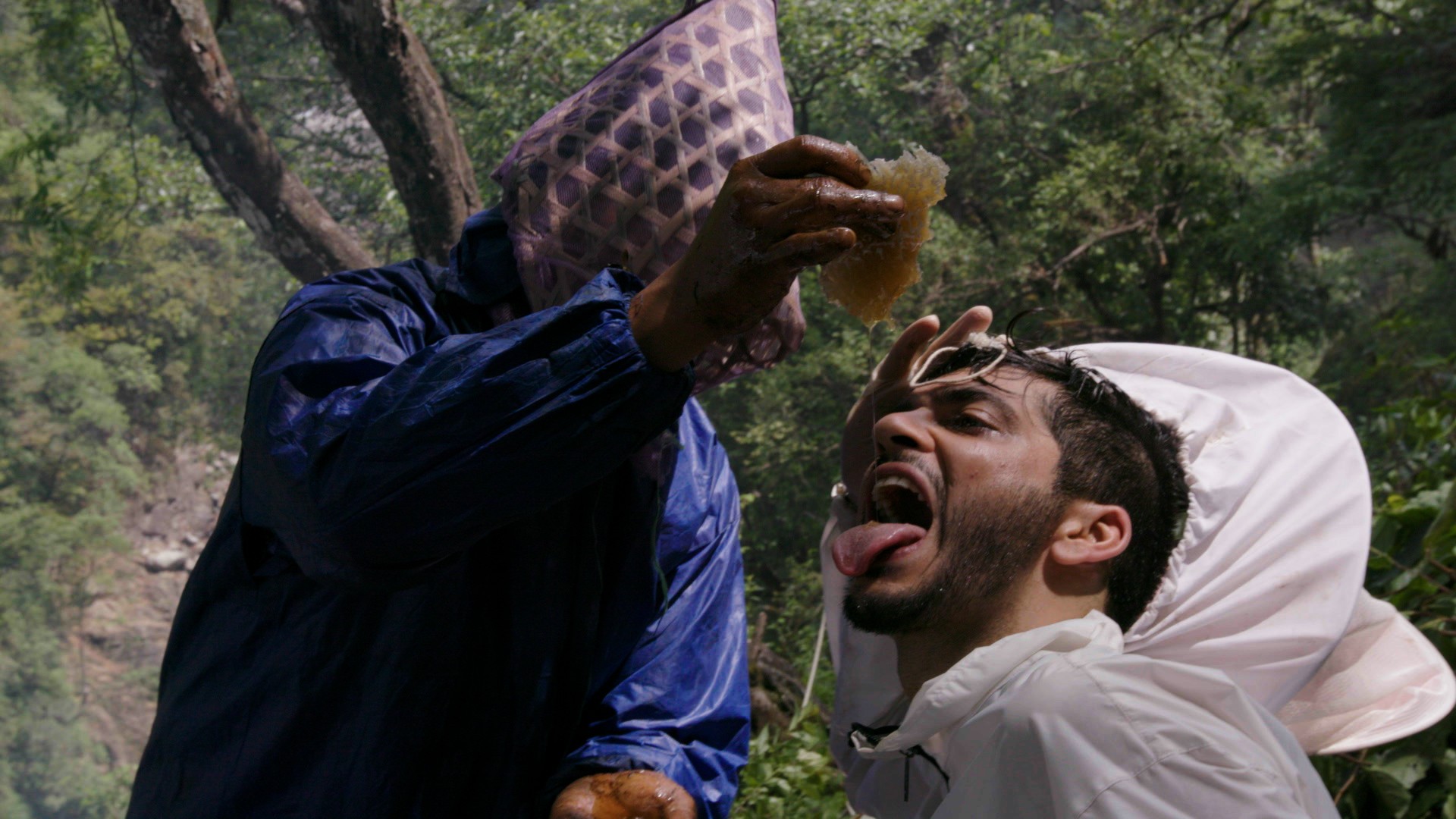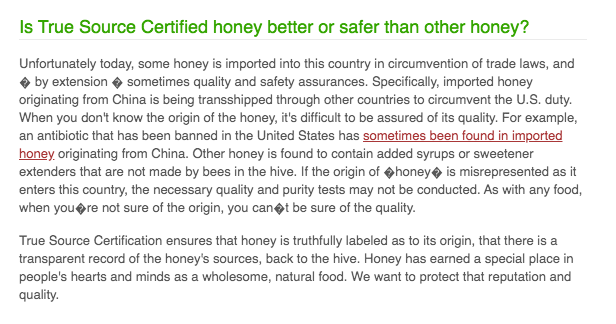Honey I tested at two food authenticity labs. Photo by Shayla Love.
Adulteration is driving global honey prices down, leaving beekeepers barely able to sell their honey for a profit.
But in a series of lawsuits filed over the last year, honey adulteration is finally being brought out of the shadows. Lawyers are finding consumers who have allegedly bought adulterated honey at their local grocery stores, and having the honey laboratory tested for proof. The accused in their complaints include major brands, and one of the dominant honey certification groups: True Source Honey, an organization that is supposed to guarantee where honey is sourced from so as to guarantee its quality.“These battles that are being fought are battles of survival."
Watch more from VICE:

Honey can deceive in many ways. Some honeys are heated to high temperatures, for easier manipulation and to avoid crystallization, but are presented as raw. Others are diluted with different kinds of sugar or syrups, made from rice, beet, corn, or other plants. Honey can be extracted while it’s still immature (when it's not yet honey, but a nectar product), or labeled as local when instead it comes from overseas.Honey can also be filtered through something called aliphatic resin—a washing machine for honey that would be unpalatable to sell to most Western markets. This resin technology removes contaminants from food, and when it's used on honey, it can obscure where honey came from and also remove particles adulterators don’t want others to know were there, like antibiotics, pesticides, or unwanted flavors.Take Indian gum honey, for example: "Tastes and smells like old gym socks," said Jim Gawenis, a biochemist and the owner of Sweetwater Science, an independent food-authenticity laboratory with International Organization for Standardization (ISO) accreditation. "You can’t sell it because nobody wants it. Well, dissolve it in water, run it through this, now you’ve gone three shades lighter into an amber. You get rid of the malodors, and now you have a sellable honey.” (Sweetwater is one of the labs where I did my testing, as well as the lab that plaintiffs’ lawyers are using to collect evidence for their suits.)
True Source is a voluntary program with more than 600 members, and Marks said that there are annual audits on True Source members when they go onto sites unannounced and inspect them, look at their records, and pull random samples.Marks said that their certification doesn't address quality factors in honey, just tracks where it comes from. Yet, according to their website, True Source certification monitors where honey comes from to ensure that honey doesn't come from countries that manipulate their honey. "Other honey is found to contain added syrups or sweetener extenders that are not made by bees in the hive," its website states. "As with any food, when you're not sure of the origin, you can't be sure of the quality. True Source Certification ensures that honey is truthfully labeled as to its origin, that there is a transparent record of the honey's sources, back to the hive. Honey has earned a special place in people's hearts and minds as a wholesome, natural food."“Adulteration will cause American food production to falter."
True Source certification logo.
When asked to respond to the claims made in the lawsuits, Marks, from True Source, and Gary Strange, from Strange Honey Farms, both told VICE that they will be defending themselves against the allegations, and declined to comment further since cases were in process.In February, Strange Honey Farm filed a motion to dismiss alleging that the plaintiffs failed to comply with federal class action rules. As a result, the plaintiffs voluntarily withdrew the case but have said they plan to refile.Carol Hagen, the Nashville distributor for Strange Honey Farm, sent out a press release a week after the case was dismissed. In the subject line, it indicated that small businesses should be warned of suits like this one and that the suit was under investigation by the Illinois Bar Association."It is just pure fraud in our opinion. They're selling products to the American public that isn't what it says it is.”
Honey samples ready to be analyzed with nuclear magnetic resonance imaging. Photo by Ethan Weston.
Honey samples at Sweetwater Science. Photo by Ethan Weston.
When I asked True Source if they used NMR testing in the audits that they say they do, Marks said that True Source Honey is currently focused on determining what country honey comes from, and that's it. "We are presently not testing for purity," he said, though he pointed out that at the last board meeting in June 2019, a committee was formed to discuss starting purity testing too.“If customs wanted to test every single container of honey, we could do it right now,” Gawenis said. “The two things we need: desire and money.” He estimates it would cost the consumer a penny or two more per pound to test. “Desire is missing from everybody, including the consumer. But isn’t it worth it? Would you be willing to pay another dollar a pound to be certain that your honey is real?”"We knew we were getting into a relatively dark world. We had no idea how dark a world."
Jim Gawenis of Sweetwater Science. Photo by Ethan Weston.
Infographic by Koji Yamamoto
Infographic by Koji Yamamoto
Infographic by Koji Yamamoto
Infographic by Koji Yamamoto
Whole Foods and Barkman, which packs Busy Bee honey, did not respond for comment about either Sweetwater or QSI’s test results. When I reached out to Strange Farms and their distributor, Hagen, with the second round of results, Hagen told me that Strange was still being advised by his lawyer not to comment. Hagen expressed confusion that the test results would come back this way—not once, but twice. She claims that random testing from the Tennessee Department of Agriculture in May of 2019 did not find added sugar. But when I reached out to the Tennessee Department of Agriculture, they said that in their May 28, 2019 routine food safety inspection, which they do for licensed food manufacturing firms, no samples were collected, and so no adulteration was observed.Hagen also said she would look into how to keep the honey warehouse cooler in hot temperatures. (A cooler environment wouldn't change the added sugar or origin results.)"These are not simple times," Hagen said in an email. "There are legal challenges and climate challenges that we have not experience[d] before and have no explanation for. We are not the criminals in this story, we are just attempting to raise bees and sell honey and support our families. Now I have to go stand in the cold to sell honey at a farmers market.""Would you be willing to pay another dollar a pound to be certain that your honey is real?”
Gawenis putting honey samples in a centrifuge at Sweetwater Science. Photo by Ethan Weston.
So far, many beekeepers and honey packers have agreed to be Weinberg's first members of what he's calling GenuHoney. But he said that some loyal members of True Source have been resistant to join. Hiatt Honey was True Source Honey's sixth member. “It was a great idea,” Hiatt said. “But I think it’s just lost its way. It’s just a paper trail.” For that reason, Hiatt said he's joined GenuHoney, and he hopes that it gains the kind of reputation that True Source once had.While GenuHoney would provide a testing mechanism outside of the honey industry to verify authenticity, it would still place the burden on honest beekeepers and packers. Roberts thinks that retailers can step up and play a role. If they refused to buy honey unless it was proven to be tested by NMR, the effects could ripple out throughout the entire global honey market. Heitzinger and his partner aren't done with their lawsuits, either. They hope that as retailers become aware they could actually be held accountable for the honey on their shelves, they might want to do a little more digging as to where their honey is coming from and what's in it.Finally, Gawenis thinks that if consumers decided to care more too, that combination would be the perfect storm for honey adulteration. “Quite honestly, right now, Americans don’t know what honey is supposed to taste like,” Gawenis said. “You can take out the word honey and put just about any other thing like olive oil, spices, any of those things. The American palette doesn't know what it's supposed to taste like because we've been trained to not want those things. The American palette is based on bland food.""The nice thing is," he added, "especially with the younger generations coming up, there is a lot more emphasis on looking at what am I eating, and why am I eating it."Hiatt's father started Hiatt Honey around 50 years ago. “He wanted to give something for his six sons to do, which he sure did,” Hiatt said.As a commercial beekeeper, Hiatt is nomadic. Eight months of the year, he’s in California; four months are in North Dakota. He has two brothers that are in Washington for most of the year. “You follow the honey and you follow the pollination,” he said.After pollinating almonds, Hiatt will send 10,000 hives up to Washington to pollinate apples. Then the family all meets up for the summer to make honey. It's a lot of travel, and “Everything has gone up,” Hiatt said. “The price of diesel, the price of trucking, every time we go between a state, it's a quarter of a million dollars because it's $3.50 a mile now to haul bees.”"There has to be some sort of legal mechanism that punishes those who cheat.”


